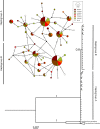World without borders-genetic population structure of a highly migratory marine predator, the blue shark (Prionace glauca)
- PMID: 28690806
- PMCID: PMC5496551
- DOI: 10.1002/ece3.2987
World without borders-genetic population structure of a highly migratory marine predator, the blue shark (Prionace glauca)
Abstract
Highly migratory, cosmopolitan oceanic sharks often exhibit complex movement patterns influenced by ontogeny, reproduction, and feeding. These elusive species are particularly challenging to population genetic studies, as representative samples suitable for inferring genetic structure are difficult to obtain. Our study provides insights into the genetic population structure one of the most abundant and wide-ranging oceanic shark species, the blue shark Prionace glauca, by sampling the least mobile component of the populations, i.e., young-of-year and small juveniles (<2 year; N = 348 individuals), at three reported nursery areas, namely, western Iberia, Azores, and South Africa. Samples were collected in two different time periods (2002-2008 and 2012-2015) and were screened at 12 nuclear microsatellites and at a 899-bp fragment of the mitochondrial control region. Our results show temporally stable genetic homogeneity among the three Atlantic nurseries at both nuclear and mitochondrial markers, suggesting basin-wide panmixia. In addition, comparison of mtDNA CR sequences from Atlantic and Indo-Pacific locations also indicated genetic homogeneity and unrestricted female-mediated gene flow between ocean basins. These results are discussed in light of the species' life history and ecology, but suggest that blue shark populations may be connected by gene flow at the global scale. The implications of the present findings to the management of this important fisheries resource are also discussed.
Keywords: gene flow; highly migratory sharks; nursery areas; panmixia.
Figures



References
-
- Aires‐da‐Silva, A. M. , Ferreira, R. L. , & Pereira, J. G. (2008). Case study: Blue shark catch‐rate patterns from the Portuguese swordfish longline fishery in the Azores In Camhi M. D., Pikitch E. K., & Babcock E. A. (Eds.), Sharks of the open ocean: biology, fisheries and conservation (pp. 230–235). Oxford, UK: Blackwell Publishing.
-
- Aires‐da‐Silva, A. M. , Hoey, J. J. , & Gallucci, V. F. (2008). A historical index of abundance for the blue shark (Prionace glauca) in the western North Atlantic. Fisheries Research, 92, 41–52.
-
- Andreotti, S. , Heyden, S. , Henriques, R. , Rutzen, M. , Meÿer, M. , Oosthuizen, H. , & Matthee, C. A. (2016). New insights into the evolutionary history of white sharks, Carcharodon carcharias . Journal of Biogeography, 43, 328–339.
-
- Beaumont, M. A. , & Nichols, R. A. (1996). Evaluating loci for use in the genetic analysis of population structure. Proceedings of the Royal Society of London B: Biological Sciences, 263, 1619–1626.
LinkOut - more resources
Full Text Sources
Other Literature Sources
Research Materials

